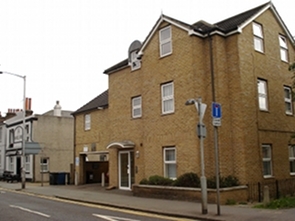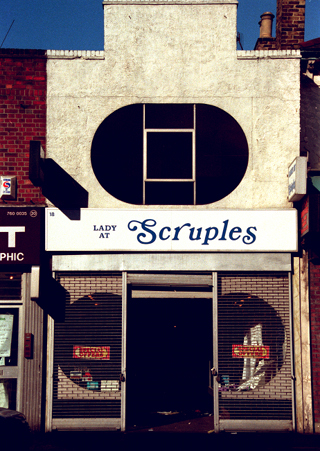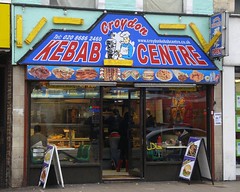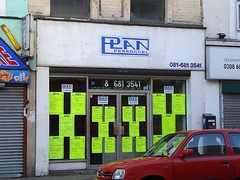18 London Road is the home of the Golden Chef’s Grill, a traditional British cafe open throughout the day. It serves fry-ups, sandwiches, burgers, tea, coffee, and so on; though in something of a departure from the usual “greasy spoon”, the premises are sparkling clean throughout, and soft drinks are served not in the can, but in a glass with ice and a straw.
This was one of the first places I ate out at after moving to West Croydon in mid-2011, and I still have quite a soft spot for it. The staff are friendly, the booths are comfortable, the mushrooms are nicely browned, the egg yolks are runny, and they’ve mastered the art of serving my favourite “very weak tea, even weaker than you think I mean”.
1860s: George Robinson, Railway Cottages
The building was definitely constructed before 1868 — it’s shown on the Town Plans surveyed in that year[1] — but I’m not sure exactly when. The first inhabitant might have been George Robinson, railway carpenter’s foreman, in the early 1860s. He certainly lived on London Road, as the 1861 census gives his address as 1 Railway Cottages, London Road, and suggests that his neighbours were Henry Anscombe at 2 Railway Cottages and Robert Spearpoint at West Croydon Station. However, street directories from around this time[2] don’t mention Railway Cottages — the Robinson and Anscombe households are simply listed as being on London Road, with no numbers — so I have only circumstantial evidence that 1 Railway Cottages did in fact later become 18 London Road.
I do find this evidence fairly convincing, though. Gray and Warren’s 1861–62 street directory lists the first four occupants along the east side of the road from the station northwards as Robert Spearpoint at the Old Station House, then George Robinson, then Henry Anscombe, and finally Meredith & Co’s Corn Stores. The Old Station House was demolished in the 1920s and replaced by the current numbers 12–14,[3] and number 16 wasn’t built until after 1868.[4] I strongly suspect that Meredith & Co were at the current number 22 (and will provide an argument for this later in this series). If so, 1 and 2 Railway Cottages must have been the current numbers 18 and 20, respectively.
1870s–1890s: Mary Ann Kingsland, servants’ registry office
In any case, if George Robinson did live here, he must have departed by the late 1860s. The first inhabitant of 18 London Road that I’m absolutely certain of is Mrs Mary Ann Kingsland, who lived here for nearly three decades from around 1869.[5]
Before moving to London Road, Mary Ann lived at 33–34 North End with her husband, Daniel Kingsland, where between them they ran a baker’s/confectioners and a servants’ registry office.[6] Daniel emigrated to New Zealand in 1868, taking some of his sons with him but leaving Mary Ann and her daughters in Croydon. Mary Ann then moved her household to 18 London Road, leaving the bakery trade behind but continuing with her servants’ registry office and branching out with a dyeing and cleaning agency as well as an antiques dealership.[7]
Mary Ann Kingsland died at the age of 70, on 21 July 1897, leaving effects valued at a total of £171 to her daughters Charlotte Emily and Frances Hannah.[9] These effects included the freehold of 18 London Road,[10] and evidence from street directories suggests that Charlotte and Frances continued to run the servants’ registry office there for a short while after their mother’s death. However, 18 London Road was put up for auction in June 1898 (see sales particulars above), and Charlotte and Frances moved their business to newly-built premises a few doors up the road.[11]

1900s–1930s: Andress Printing Company
The next business to move in to 18 London Road was a printing company, Andress & Co (later the Andress Printing Company). Andress is listed in Ward’s street directories from 1894 onwards, first at 14 Derby Road[12] and then from 1902 at 18 London Road.[13]
During the Derby Road years, Andress was the publisher of the Croydon Review, a local newspaper which was established around 1880 and lasted to around 1895.[14] The publishers before Andress were James Sampson and Alfred Davey, who also operated from 14 Derby Road; it seems that Andress simply took over Sampson and Davey’s business.[15]
While Andress definitely used its Derby Road premises for the actual printing, I’m not sure if 18 London Road was ever used for this, or if it was simply an outlet for their products. I do know that the print works were at 91–93 Waddon New Road from the early-to-mid 1930s, though the stationery shop remained at London Road until the late 1930s at least.[16]
The company changed hands around 1920, and the new owner kept the Andress name. It still exists today as Andress Printing Co Ltd, run by David Gordon, the grandson of the man who purchased it in 1920.[17] The Waddon New Road premises are long gone, though, demolished and replaced by new-build housing.
1950s: H E Howard & Co, domestic manufacturers
After Andress left London Road, number 18 was vacant for a while, as shown in my “Then and Now” photo of numbers 12–24. However, by the mid-1950s, the occupant was H E Howard & Co Ltd, listed in Kent’s 1955 directory as “domestic manufacturers”. I’m not entirely sure what a domestic manufacturer is (or was), though Blair’s 1972 directory is a little more informative, listing H E Howard & Co as “domestic woodware manufacturers”.
1970s–1980s: A series of short-lived businesses
After H E Howard, from the mid-1970s to the mid-1980s the premises were occupied by a series of short-lived businesses: Gulsons, Jivegate, Centview, and Elegant Electronics. These all sold the same sorts of things: TV/radio equipment, jewellery, “fancy goods”, and gifts. Next came Scruples ladieswear, present by April 1986 but gone again a couple of years later.[18]
1990s: Gees Diner
In May 1989, planning permission was granted for “use of part of the ground floor and first floor as cafe”.[19] This cafe was very likely the occupant shown in the March 1990 Goad plan: Gees Diner, listed as a restaurant but probably more of a cafe. This was also a fairly short-lived business, but one which set the stage for the cafe of today.
1990s–present: Star Express, Jenny’s, Croydon Grill, and Golden Chef’s Grill
The cafe at 18 London Road has now been run by the same family for over two decades.[20] The patriarch of this family, Mr Ozdemir, lived in Thornton Heath in the 1970s, and so regularly passed 18 London Road on his route to work at Texas Pancake on North End (where Pizza Hut is today). He moved out of the area for a while, but when he moved back around 1992–3, he took over the premises previously occupied by Gees Diner and set it up as a Star Express franchise.
After experimenting with a different franchise — Jenny’s — the cafe finally went independent under the name Croydon Grill. Another name change, to Golden Chef’s Grill, took place in the early 2000s and was accompanied by a revamped menu. The manager today is Yemen Ozdemir, son of the original owner; he started in the family business as a washer-up, and now runs the Golden Chef as a friendly and welcoming cafe, well-patronised by the people of West Croydon. Why not pop in for a cup of tea next time you’re in the area?
Thanks to: David Gordon; Yemen Ozdemir; Brian Gittings; Stiles Harold Williams; the Planning Technical Support Team at Croydon Council; all at the Croydon Local Studies Library; and my beta-readers bob, Flash, and Kat.
Footnotes and references
- I refer here to the first edition of the 1:500 Town Plans, survey date 1868, which shows buildings in the same positions as today’s numbers 18 and 20. Street directories show an unbroken series of occupants in these premises (aside from when the addresses are explicitly shown as “unoccupied”) from 1869 until 1939 (which is when yearly directories cease), so if they were demolished and rebuilt this would have to have happened after 1939. Looking at the buildings today, they clearly predate 1939, so must be the same buildings that were present in 1868. They were however extended forwards between 1868 and 1895; the 1868 Town Plans show numbers 18, 20, and 22 each with a small front garden, but in the 1894–5 Town Plans the gardens have vanished and the frontages have moved closer to the road (see Town Plans excerpts in article 16). One can speculate whether a member of Mary Ann Kingsland’s family was involved in these extensions. Ward’s 1876 directory makes a brief mention of H Kingsland, builder, with his private address at the same premises where Mary Ann Kingsland ran her servants’ registry office. The 1861 and 1871 censuses reveal that this must have been her son, Henry G Kingsland. So perhaps he had something to do with the changes to the properties.
- I’ve looked at all the street directories available at the Croydon Local Studies Library from 1849 to 1939. None of them mention Railway Cottages.
- See my article on 12–14 London Road.
- See my article on 16 London Road.
- Although most of the properties on the east side of London Road didn’t acquire numbers until 1890, Mary Ann Kingsland appears in street directories from 1869 to 1897 inclusive, and hence it’s clear that she was at number 4, which in 1927 was renumbered to the present-day 18.
- Gray and Warren’s 1861–2 directory and Warren’s 1865–66 directory list Daniel Kingsland, Baker & Confectioner and Registry Office for Servants, at 33-34 North End. Mary Ann isn’t mentioned in these directories, but given that she successfully ran a servants’ registry office from London Road after her husband emigrated, it seems likely that she had previous experience gained from her time at North End.
- Information on Daniel’s emigration to New Zealand provided by his great-great-great granddaughter (via email, 1 March 2015). Mary Ann first appears on London Road in Warren’s 1869 directory, and she’s the only Kingsland listed in this directory. Furthermore, the 1871 census lists her as the head of the household (and married, rather than a widow). Warren’s 1869 directory lists Mary Ann Kingsland as a “Dyer and Cleaner (agency) — and Registry for Servants”. Ward’s directories consistently list Mary Ann’s business as the registry office alone, but Kelly’s 1889, 1890, 1891, and 1893 directories list her as an antiques dealer as well. This is clearly a difference in policy between directory-makers, but I don’t have access to Kelly’s directories prior to 1889 to see if they mention the antiques as well.
- Sales particulars viewed and copied at the Croydon Local Studies Library. A copy is bound in the Harold Williams volume for 1898, and another is available loose under ref CR723.
- The National Probate Calendar (Index of Wills and Administrations), 1858–1966 lists Mary Ann Kingsland of 4 London Road as having died on 21 July 1897, with “Probate London 13 August to Charlotte Emily Kingsland and Frances Hannah Kingsland spinsters Effects £171”. (Brenda Hawkins tells me that the figure of £171 is a summary of the net value of the estate, to work out how much tax should be paid.) Charlotte and Frances are listed as Mary Ann’s daughters in the 1871 and 1881 censuses. The Free BMD Death Index, 1837–1915 states that Mary Ann was 70 when she died, which is consonant with the age of 24 given in the 1851 census. All of these sources consulted via Ancestry at the Croydon Local Studies Library.
- The November 1896 Poor Rate Book, held at Croydon Local Studies Library, lists the owner of the property occupied by Mary Ann Kingsland as “Kingsland” (i.e. Mary Ann herself) and the rateable value of the property as £28.
- Ward’s 1898 and 1899 directories list “The Misses Kingsland” as running a registry office for servants at 4 London Road (i.e. the property that today is numbered 18); Kelly’s 1899 directory confirms that they also continued their mother’s antiques business. Ward’s 1900 directory lists 4 London Road as “unoccupied”, and the Misses Kingsland at number 8a (i.e. modern 24–26, which despite the double number is not a double shopfront — more on this later in this series). It’s clear that 8a was newly built at this point, as Ward’s 1889 directory lists “two shops building” between 6 and 10; in 1900 these appear as 8 and 8a.
- This address no longer exists. Street directories from the 1890s list it as being on the north side of the road, just after the junction with Parsons Mead and some way before the junction with Derby Grove. Derby Grove also no longer exists, but the 1894–96 1:2500 Ordnance Survey map shows this road as being between Parsons Mead and present-day Pitlake. Hence, 14 Derby Road would have been just west of Parsons Mead, on the little triangle of land that today is an open grassy area (the abovementioned map shows that the premises on this site occupied the whole of this little triangle). Further evidence for its location comes from the engraving shown in this article; the premises are clearly on a corner.
- Actually 4 London Road in the numbering of the time. From 1894 to 1901 (inclusive), Andress & Co is listed at 14 Derby Road. In 1902, 14 Derby Road is listed as unoccupied. From 1902 to 1939 (inclusive) Andress is listed at 18 London Road (4 London Road before the 1927 renumbering) under different variations of its name: Andress & Co, Smith & Andress Ltd, and Andress Printing & Publishing Co. An advertisement in the 1934 directory (shown in article) uses the name Andress Printing Company. From 1932 to 1939 (inclusive), Andress is also listed at 91–93 Waddon New Road. I have no access to street directories after 1939 until Heath’s 1949 directory, which makes no mention of either Andress or 18 London Road.
- According to Croydon Online, the Croydon Review was published from 1879 to 1895, but no reference is given for this information. The earliest issue on microfilm at the Croydon Local Studies Library is from April 1880. Someone has written “No 1” on the masthead, but the same issue makes reference to a small piece in the Croydon Guardian of 6 March 1880, praising “The March number of this excellent and useful little work [i.e. the Croydon Review]”, so April 1880 can’t possibly have been the first edition. (I’ve confirmed this by looking at the relevant Croydon Guardian issue myself on microfilm.) The last Croydon Review issue on microfilm is November 1895; this issue makes no mention of an upcoming end to publication, which might indicate that this end was not actually planned.
- A clue as to exactly when Andress took over from Sampson and Davey might be gained from the change in format of the Croydon Review between March and April 1893. The newspaper was initially a small-format monthly, but by the early 1890s it had become a large-format weekly one. The last weekly edition was published on 25 March 1893; the next edition after that was April 1893, abruptly back to the small format monthly of the earlier years. One can speculate whether this was due to a change of publisher; having looked at both abovementioned issues, as far as I can see no explanation was given in the newspaper itself. Andress were definitely in charge by February 1894, as that month’s issue includes a copy of the engraving of the Derby Road premises shown above, with “Andress & Co” above the door.
- David Gordon, who runs the company today, is the grandson of the 1920 purchaser. He tells me: “The Shop became Edenborough's stationery shop. The son in law (of that name) and daughter of my Grandfather took over the stationery side and Andress moved as you say to Waddon New Road.” He also notes that 93 Waddon New Road was previously the home of the composer Joseph Holbrooke, and that he used to do all his typesetting in Holbrooke’s old bedroom. I haven’t found any documentary evidence of where the print works were between 1902 and 1932, but according to David they were behind where Argos in Church Street is now. (All information provided via email, April and May 2013.)
- Information on purchase of company provided by David Gordon (via email, April and May 2013).
- The August 1974 Goad plan lists Gulsons, “R/TV audio jwly fancy goods”. Brian Gittings’ 1980 journal of Croydon retail lists Jivegate Ltd, “watches gifts radio”. The March 1983 and March 1984 Goad plans list Centview Ltd, “gifts”. The 1984–85 London Shop Surveys list Centview, “Rad, Jewellery”. The 1986–87 London Shop Surveys list Elegant Electronics, “Aud, Elec”. The April 1986 and April 1987 Goad plans list Scruples, “l/wear”. (The 1988–89 London Shop Surveys list Crispins fish & chips, but I think this is a misprint — Crispins was actually at number 30.) The March 1990 Goad plan lists Gees Diner.
- Information on this planning application comes from an index card viewed at Croydon Council offices. The reference number for the application is 89/719/P. I wasn’t able to view the application itself because the staff were unable to locate it in their filing system.
- All information about the Ozdemir family and their tenure at 18 London Road provided by Yemen Ozdemir (in conversation with the author, 18 May 2013). The relevant documentary evidence is as follows: 18 London Road is listed as Gee’s Diner in the March 1990 Goad plan; as “vacant restaurant” in the June 1992 Goad plan; as Jennys [sic] fast food restaurant in the April 1994 Goad plan; as Starburger fast food restaurant in the June 1995 Goad plan; as Star Express in the September 1999 Goad plan and the second edition (probably c.2002) of Shop ‘Til You Drop; and as Golden Chef’s Grill in the May 2002 Goad plan. There’s a slight discrepancy with the oral evidence here, but I didn’t have time to resolve it in time for publication. Jennys is also mentioned in records relating to a planning application for number 74 (ref 92/2622/P), specifically in a letter from the applicant’s architects listing nearby food-related places.
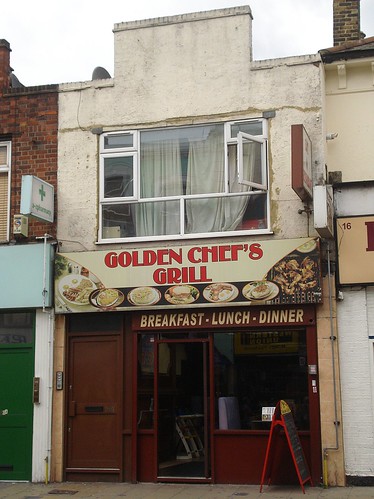
![Sign on building to left reads: “The Wandle Arms / Free House / Real Ales / Function Room / Lunches & Bar Snacks / [indecipherable telephone number]”. Signs on main building all read “Andress Printing”. A two-storey building with three pairs of windows along the upper floor. The outside has been painted white, but there are clear signs of weathering. The windowframes and doors are painted red. Two signs on the frontage read “Andress Printing”. A painted sign on the side of the building shows the same text, but has worn away with time. The side of the Wandle Arms pub is visible to the left.](/history/images/0018/andress-print-works-waddon-new-road.jpg)
